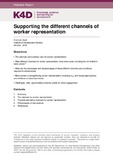Supporting the Different Channels of Worker Representation
Abstract
This rapid review synthesises the literature from academic, policy, and knowledge institution sources on the different channels to strengthen worker representation in low- and middle-income countries (LMICs). Most of the literature on worker representation (a way to increase workers’ voice) comes from high-income countries. Where relevant for LMICs, some of this literature is used in this rapid review. Evidence from LMICs, mainly comes from the more industrialised middle-income countries, mainly in Latin America, but also in South Africa, India and Bangladesh, while few evidence comes from low-income countries. Overall, the evidence that makes a ‘business case’ for worker representation shows that Trade union members have higher wages than non-union members through collective bargaining. Secondly, higher wages are often paid back through an increase in productivity at firm-level. It seems that effective employee engagement strategies (or meaningful participation) positively relates to affective organisational commitment and trust, which result in higher level of activity, initiative and responsibility. Thirdly, The literature shows strong research evidence of positive association between trade union supported health and safety representatives and improved health and safety outcomes in many sectors, in particular in high-income countries. Finally, Some scholars mention that the presence of strong unions reduce income inequality and that it was instrumental in maintaining democracy, economic order, and social stability in times of crises. Worker representation is also linked with more gender equality through the involvement of women in collective bargaining and other negotiations.
Citation
Quak, E. (2019). Supporting the different channels of worker representation. K4D Helpdesk Report No 590. Brighton, UK: Institute of Development Studies.Is part of series
K4D Helpdesk Report;615Rights holder
© DFID - Crown copyright 2019Collections
- K4D [937]

